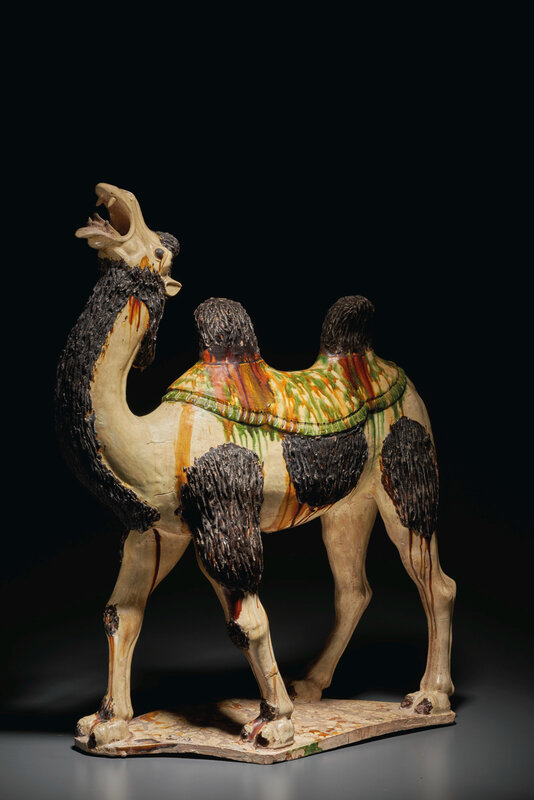A massive sancai and brown-glazed pottery figure of a Bactrian camel, Tang dynasty (AD 618-907)
Lot 1807. A massive sancai and brown-glazed pottery figure of a Bactrian camel, Tang dynasty (AD 618-907); 32 ¾ in. (83.5 cm.) high. Estimate USD 100,000 - USD 150,000. Price realised USD 200,000. © Christie's Image Ltd 2020
The camel is finely modelled striding on a shaped base, with its head lifted and mouth open in a bray, the muscular body is covered in a rich cream glaze, with textured areas of dark brown hair on the neck, thighs, body and humps, and the splash-glazed, fitted blanket has an incised border.
Property from the Collection of Frederick A. and Sharon L. Klingenstein.
Provenance: Eskenazi Ltd., London, 1979.
Dr and Mrs G. Fabbri, Lugano, Switzerland.
Eskenazi Ltd., London, 1986.
Note: This massive and exceptionally handsome camel is a particularly fine example of the type of figure that was made to go into the tombs of the Tang elite in the first half of the eighth century. Such models provided an obvious indication of the wealth of the family who could afford to inter such costly goods with their deceased relative. Figures of camels have been found among the burial items in a number of the Tang Imperial tombs, as well as some of those belonging to other members of the Tang nobility. However, these models were not simply symbols of wealth, they were also symbols of the way that wealth might have been acquired through trade and tribute along the Silk Route. In the Tang dynasty, camels really did live up to the description of them as 'ships of the desert', and were used to transport Chinese goods including silk across the difficut terrain of the Silk Route to the markets of Central Asia, Samarkand, Persia and Syria. On their return journeys, they carried many of the exotic luxuries from the west that were desired by the sophisticated Tang court at Chang'an.
The two-humped Bactrian camel, known in China from as early as the Han dynasty, was originally brought from Central Asia and Eastern Turkestan as tribute. Its ability to survive the hardships of travel across the Asian deserts was soon recognized and Imperial camel herds were established under the administration of a special Bureau. These Imperial camel herds, numbering in the thousands, were used for a range of state duties, including the provision of a military courier service for the northern frontier. Camels were not only prized for resilience but also for their hair, which was used to produce cloth, admired for its lightness and warmth, and when necessary for their meat and milk during the long treks.
Figures of Bactrian camels of this unusually large size are known standing foursquare as well as striding, in various glaze combinations, and either laden with a pack or without. The more usual glaze combination is an amber body with straw or cream-glazed areas of hair, as seen on the large figure of a Bactrian camel illustrated in the catalogue Chugoku no Toji, Tokyo National Museum, 12 October-23 November 1994, p. 87, no. 122, and another sold at Christie's New York, 19 March 2008, lot 512. The most unusual combination appears to be that seen on the present figure and another similarly large (86.2 cm. high), striding figure of a Bactrian camel illustrated in Tang, Eskenazi, London, June-July 1987, no. 38. Both the present figure and the Eskenazi figure have similar textured areas of hair glazed dark brown in contrast to the cream glaze of the body, but unlike the present figure the Eskenazi figure does not have a fitted, splash-glazed blanket.
The result of the Research Laboratory for Archaeology, Oxford, thermoluminescence test dated 12 August 1987 is consistent with the dating of this lot.
Christie's. Important Chinese Ceramics and Works of Art, New York, 25 September 2020.

/https%3A%2F%2Fprofilepics.canalblog.com%2Fprofilepics%2F1%2F0%2F100183.jpg)
/https%3A%2F%2Fstorage.canalblog.com%2F03%2F02%2F119589%2F96711876_o.jpg)
/https%3A%2F%2Fstorage.canalblog.com%2F11%2F31%2F119589%2F94773502_o.jpg)
/https%3A%2F%2Fstorage.canalblog.com%2F20%2F83%2F119589%2F94772815_o.jpg)
/https%3A%2F%2Fstorage.canalblog.com%2F26%2F72%2F119589%2F75604929_o.jpg)
/https%3A%2F%2Fstorage.canalblog.com%2F59%2F60%2F119589%2F26458628_o.jpg)





/http%3A%2F%2Fstorage.canalblog.com%2F68%2F73%2F119589%2F129761208_o.jpg)
/http%3A%2F%2Fstorage.canalblog.com%2F93%2F84%2F119589%2F129704643_o.jpg)
/http%3A%2F%2Fstorage.canalblog.com%2F35%2F94%2F119589%2F129242745_o.jpg)
/http%3A%2F%2Fstorage.canalblog.com%2F76%2F75%2F119589%2F129242347_o.jpg)